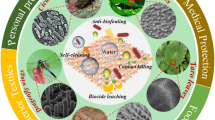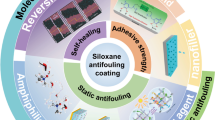Abstract
A simple, efficient, and economical method was developed to fabricate superhydrophobic surfaces on various substrates, including wood, bamboo, cotton, filter paper, sponge, glass, textile, and copper. This method involves synthesizing a two-component modifier solution consisting of SiO2 nanoparticles combined with poly(methylhydrogen)siloxane (PMHS) modification. The superhydrophobicity of the coated surfaces was created by PMHS combined with SiO2 nanoparticles to construct a rough hierarchical structure on the surface of the substrate. All superhydrophobic surfaces were maintained at a relative humidity of 50% for 30 days in an indoor environment and subsequently, the superhydrophobic surfaces were kept minus 20 °C for 24 h. It was confirmed that these surfaces exhibited excellent self-cleaning, oil/water separation, and elimination of underwater oil properties. The method for fabricating superhydrophobic materials proposed in this study will have great potential to prepare large-scale superhydrophobic surfaces for use in ancient building protection.
Graphic abstract










Similar content being viewed by others
References
Boinovich LB, Emelyanenko AM, Emelyanenko KA, Maslakov KI (2016) Anti-icing properties of a superhydrophobic surface in a salt environment: an unexpected increase in freezing delay times for weak brine droplets. Phys Chem Chem Phys 18(4):3131–3136
Cao L, Jones AK, Sikka VK, Wu J, Gao D (2009) Anti-Icing superhydrophobic coatings. Langmuir 25(21):12444–12448
Chang H, Tu K, Wang X, Liu J (2015) Fabrication of mechanically durable superhydrophobic wood surfaces using polydimethylsiloxane and silica nanoparticles. RSC Adv 5(39):30647–30653
Chen Y, Zhang Y, Shi L, Li J, Xin Y, Yang T, Guo Z (2012) Transparent superhydrophobic/superhydrophilic coatings for self-cleaning and anti-fogging. Appl Phys Lett 101(3):033701–033707
Cho EC, Changjian CW, Chen HC, Chuang KS, Zheng JH, Hsiao YS, Lee KC, Huang JH (2017) Robust multifunctional superhydrophobic coatings with enhanced water/oil separation, self-cleaning, anti-corrosion, and anti-biological adhesion. Chem Eng J 314:347–357
Daniello RJ, Waterhouse NE, Rothstein JP (2009) Drag reduction in turbulent flows over superhydrophobic surfaces. Phys Fluids 21(8):625–634
Fürstner R, Barthlott W, Neinhuis C, Walzel P (2005) Wetting and self-cleaning properties of artificial superhydrophobic surfaces. Langmuir 21(3):956–961
Feng L, Li S, Li Y, Li H, Zhang L, Zhai J, Song Y, Liu B, Jiang L, Zhu D (2002) Super-hydrophobic surfaces: from natural to artificial. Adv Mater 14(24):1857–1860
Fernández-Blázquez JP, Fell D, Bonaccurso E, Campo AD (2011) Superhydrophilic and superhydrophobic nanostructured surfaces via plasma treatment. J Colloid Interface Sci 357(1):234–238
Han D, Moon SY (2015) Development of superhydrophobic surface on glass substrate by multi-step atmospheric pressure plasma treatment. Thin Solid Films 587(31):34–38
Han X, Yin Y, Zhang Q, Li R, Pu J (2018) Improved wood properties via two-step grafting with itaconic acid (IA) and nano-SiO2. Holzforschung 72(6):499–506
Hu Z, Zen X, Gong J, Deng Y (2009) Water resistance improvement of paper by superhydrophobic modification with microsized CaCO3 and fatty acid coating. Colloids Surf A 351(1–3):65–70
Huang W, Zhang L, Lai X, Li H, Zeng X (2020) Highly hydrophobic F-rGO@wood sponge for efficient clean-up of viscous crude oil. Chem Eng J 386:123994
Jia S, Chen H, Luo S, Qing Y, Deng S, Yan N, Wu Y (2018) One-step approach to prepare superhydrophobic wood with enhanced mechanical and chemical durability: driving of alkali. Appl Surf Sci 455:115–122
Jia S, Liu M, Wu Y, Luo S, Qing Y, Chen H (2016) Facile and scalable preparation of highly wear-resistance superhydrophobic surface on wood substrates using silica nanoparticles modified by VTES. Appl Surf Sci 386:115–124
Lai Y, Tang Y, Gong J, Gong D, Chi L, Lin C, Chen Z (2012) Transparent superhydrophobic/superhydrophilic TiO2-based coatings for self-cleaning and anti-fogging. J Mater Chem 22(15):7420–7426
Lee C, Kim CJ (2011) Underwater restoration and retention of gases on superhydrophobic surfaces for drag reduction. Phys Rev Lett 106(1):014502–014506
Li J, Lu Y, Wu Z, Bao Y, Xiao R, Yu H, Chen Y (2016) Durable, self-cleaning and superhydrophobic bamboo timber surfaces based on TiO2 films combined with fluoroalkylsilane. Ceram Int 42(8):9621–9629
Lin W, Huang Y, Li J, Liu Z, Yang W, Li R, Chen H, Zhang X (2018) Preparation of highly hydrophobic and anti-fouling wood using poly(methylhydrogen)siloxane. Cellulose 25(12):7341–7353
Lin W, Zhang X, Cai Q, Yang W, Chen H (2020) Dehydrogenation-driven assembly of transparent and durable superhydrophobic ORMOSIL coatings on cellulose-based substrates. Cellulose 27(1):7805–7821
Liu Z, Yu J, Lin W, Yang W, Li R (2018) Facile method for the hydrophobic modification of filter paper for applications in water-oil separation. Surf Coat Technol 352:313–319
Lu Y, Feng M, Zhan H (2014) Preparation of SiO2-wood composites by an ultrasonic-assisted sol–gel technique. Cellulose 21(6):4393–4403
Ma M, Mao Y, Gupta M, Gleason KK, Rutledge GC (2005) Superhydrophobic fabrics produced by electrospinning and chemical vapor deposition. Macromolecules 38(23):9742–9748
Miao H, Bao F, Cheng L, Shi W (2010) Cotton fabric modification for imparting high water and oil repellency using perfluoroalkyl phosphate acrylate via γ-ray-induced grafting. Radiat Phys Chem 79(7):786–790
Mikhail B, Vadim A, Igor K, Andrey S, Aleksey L, Maltseva T (2016) Usage of spatial lattice metal structures as roofing for mechanical equipment rooms of hydroelectric power stations. Matec Web Conf 73:01012–01018
Okon KE, Lin F, Lin X, Chen C, Chen Y, Huang B (2018) Modification of Chinese fir (Cunninghamia lanceolata L.) wood by silicone oil heat treatment with micro-wave pretreatment. Eur J Wood Wood Prod 76(1):221–228
Poaty B, Riedl B, Blanchet P, Blanchard V, Stafford L (2013) Improved water repellency of black spruce wood surfaces after treatment in carbon tetrafluoride plasmas. Wood Sci Technol 47(2):411–422
Qiu S, Xue M, Zhu G (2014) Metal–organic framework membranes: from synthesis to separation application. Chem Soc Rev 43(16):6116–6140
She Z, Li Q, Wang Z, Li L, Chen F, Zhou J (2013) Researching the fabrication of anticorrosion superhydrophobic surface on magnesium alloy and its mechanical stability and durability. Chem Eng J 228:415–424
Su X, Li H, Xue L, Zhang L, Wang J, Liao X, Zeng X (2017) Vapor–liquid sol–gel approach to fabricating highly durable and robust superhydrophobic polydimethylsiloxane@silica surface on polyester textile for oil–water separation. ACS Appl Mater Interface 9(33):28089–28099
Su X, Li H, Xue L, Zhang L, Liao X, Wang J, Chen Z, He J, Zeng X (2018) Dual-functional superhydrophobic textile with asymmetric roll-down/pinned states for water droplet transportation and oil-water separation. ACS Appl Mater Interface 10(4):4213–4221
Taurino R, Fabbri E, Messori M, Pilati F, Pospiech D, Synytska A (2008) Facile preparation of superhydrophobic coatings by sol–gel processes. J Colloid Interface Sci 325(1):149–156
Tu K, Wang X, Kong L, Guan H (2018) Facile preparation of mechanically durable, self-healing and multifunctional superhydrophobic surfaces on solid wood. Mater Des 140:30–36
Wang J, Chen H, Sui T, Li A, Chen D (2009) Investigation on hydrophobicity of lotus leaf: experiment and theory. Plant Sci 176(5):687–695
Wang S, Liu C, Liu G, Zhang M, Li J, Wang C (2011) Fabrication of superhydrophobic wood surface by a sol–gel process. Appl Surf Sci 258(2):806–810
Wang S, Wang C, Liu C, Zhang M, Ma H, Li J (2012) Fabrication of superhydrophobic spherical-like α-FeOOH films on the wood surface by a hydrothermal method. Colloids Surf A 403:29–34
Wang X, Liu S, Chang H, Liu J (2014) Sol–gel deposition of TiO2 nanocoatings on wood surfaces with enhanced hydrophobicity and photostability. Wood Fiber Sci 46(1):109–117
Wu Y, Qing Y, Liang J, Liu M, Luo S (2015) Facile fabrication of superhydrophobic surfaces on wood substrates via a one-step hydrothermal process. Appl Surf Sci 330:332–338
Wu Y, Jia S, Qing Y, Luo S, Liu M (2016) A versatile and efficient method to fabricate durable superhydrophobic surfaces on wood, lignocellulosic fiber, glass, and metal substrates. J Mater Chem 4(37):14111–14121
Xue Z, Wang S, Lin L, Chen L, Liu M, Feng L, Jiang L (2011) A novel superhydrophilic and underwater superoleophobic hydrogel-coated mesh for oil/water separation. Adv Mater 23(37):4270–4273
Zhang C, Zhang S, Gao P, Ma H, Wei Q (2014) Superhydrophobic hybrid films prepared from silica nanoparticles and ionic liquids via layer-by-layer self-assembly. Thin Solid Films 570:27–32
Zhang L, Li Y, Sun J, Shen J (2008) Layer-by-layer fabrication of broad-band superhydrophobic antireflection coatings in near-infrared region. J Colloid Interface Sci 319(1):302–308
Zhang W, Shi Z, Zhang F, Liu X, Jin J, Jiang L (2013) Superhydrophobic and superoleophilic PVDF membranes for effective separation of water-in-oil emulsions with high flux. Adv Mater 25(14):2071–2076
Zhang L, Li H, Lai X, Su X, Liang T, Zeng X (2017) Thiolated graphene-based superhydrophobic sponges for oil-water separation. Chem Eng J 316:736–743
Zheng Z, Gu Z, Huo R, Ye Y (2009) Superhydrophobicity of polyvinylidene fluoride membrane fabricated by chemical vapor deposition from solution. Appl Surf Sci 255(16):7263–7267
Zhou L, Xu S, Zhang G, Cai D, Wu Z (2016) A facile approach to fabricate self-cleaning paint. Appl Clay Sci 132–133:290–295
Acknowledgments
The authors gratefully acknowledge the support from the Leading Project of Fujian Province of China (2019H0008) and the National Natural Science Foundation of China (61505029).
Author information
Authors and Affiliations
Corresponding authors
Additional information
Publisher's Note
Springer Nature remains neutral with regard to jurisdictional claims in published maps and institutional affiliations.
Supplementary Information
Below is the link to the electronic supplementary material.
Supplementary file 1 (MP4 3910 kb)
Supplementary file 2 (MP4 2448 kb)
Rights and permissions
About this article
Cite this article
Lin, W., Cao, M., Olonisakin, K. et al. Superhydrophobic materials with good oil/water separation and self-cleaning property. Cellulose 28, 10425–10439 (2021). https://doi.org/10.1007/s10570-021-04175-0
Received:
Accepted:
Published:
Issue Date:
DOI: https://doi.org/10.1007/s10570-021-04175-0




